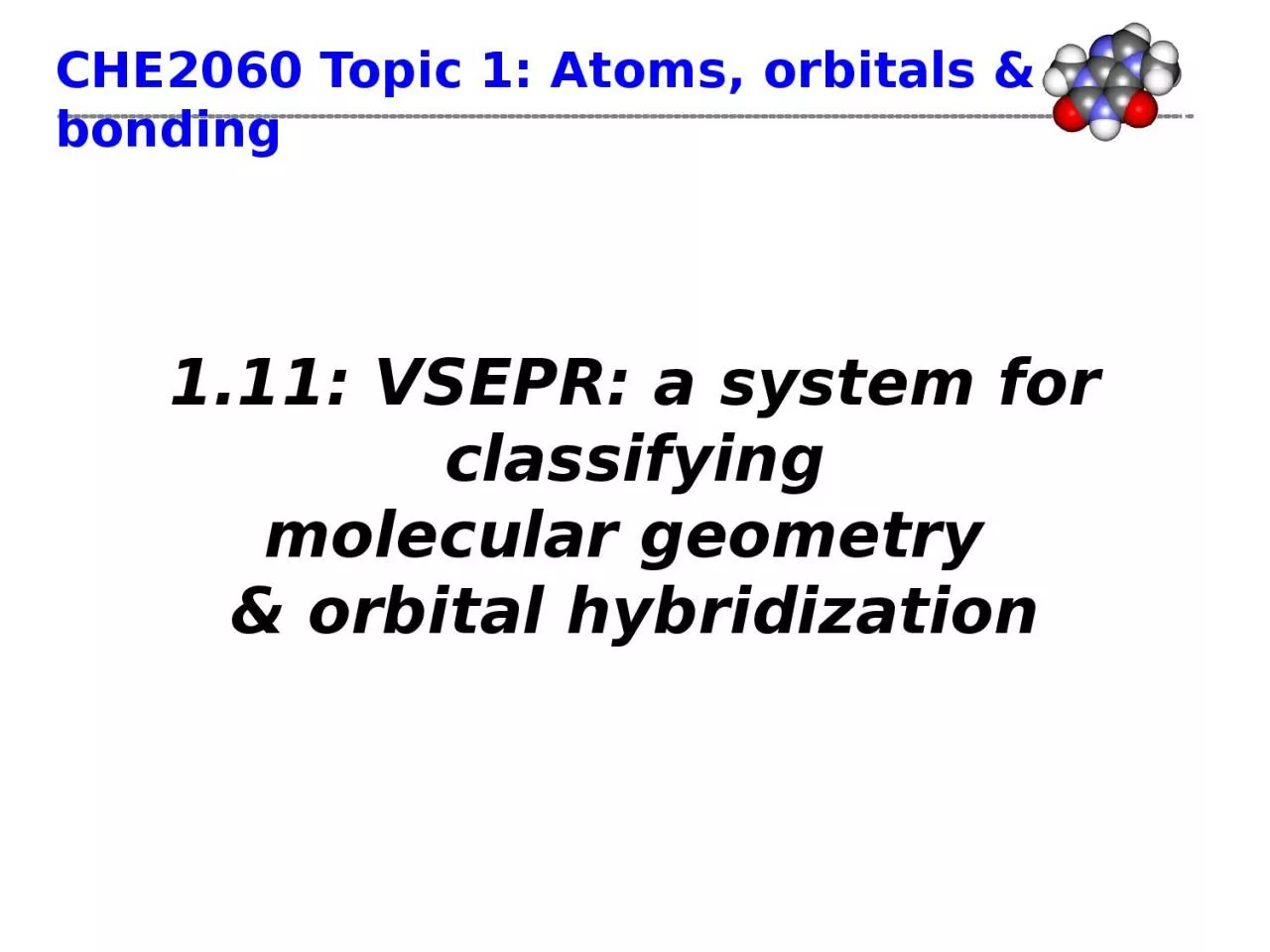

molecular geometry amp orbital hybridization CHE2060 Topic 1 Atoms orbitals amp bonding VSEPR categorizes geometry amp hybridization lone e pr bonds e pair geometry ID: 1025531
Download Presentation The PPT/PDF document "1.11: VSEPR : a system for classifying" is the property of its rightful owner. Permission is granted to download and print the materials on this web site for personal, non-commercial use only, and to display it on your personal computer provided you do not modify the materials and that you retain all copyright notices contained in the materials. By downloading content from our website, you accept the terms of this agreement.
1. 1.11: VSEPR: a system for classifyingmolecular geometry & orbital hybridizationCHE2060 Topic 1: Atoms, orbitals & bonding
2. VSEPR categorizes geometry & hybridization# lone e- pr# bondse- pair geometryMoleculargeometryBondAngle (°)02linearlinear18003trigonal planartrigonal planar12012trigonal planarbent< 12004tetrahedraltetrahedral109.513tetrahedraltrigonal pyramidal< 109.522tetrahedralbent<109.505trigonal bipyramidaltrigonal bipyramidal90, 120, 18014trigonal bipyramidalseesaw90, 120, 18023trigonal bipyramidalT-shaped90, 18032trigonal bipyramidallinear18006octahedraloctahedral90, 18015octahedralsquare pyramidal90, 18024octahedralsquare planar90, 180http://intro.chem.okstate.eduspsp2sp3sp3dsp3d2
3. sp2 geometriesMolecules whose central atom is sp2 hybridized have similar electron pair &molecular geometriesElectron pair geometry: trigonal planarMolecular geometry:trigonal planar (zero lone pair)bent (1 lone pair)A closer look at electron pair geometries:Note that each lp produces a different geometry;When there is more than one lp, note that theyare found as far away from each other aspossible. Generally, switching any two substituents (toform an isomer) pushes some groups closertogether and creates a less stable molecule.
4. sp3 geometriesMolecules whose central atom is sp3 hybridized have greater differencesbetween electron pair & molecular geometriesElectron pair geometry: tetrahedralMolecular geometry:tetrahedral (zero lone pairs)trigonal pyramidal (1 lone pairs)Bent (2 lone pairs)
5. sp3d geometriesMolecules whose central atom is sp3d hybridized have more differencesbetween electron pair & molecular geometriesElectron pair geometry: trigonal bipyramidalMolecular geometry:trigonal bipyramidal (zero lone pairs)seesaw (1 lone pairs)T-shaped (2 lone pairs)linear (3 lone pairs)
6. sp3d2 geometriesMolecules whose central atom is sp3d2 hybridized have a bit less variationbetween electron pair & molecular geometriesElectron pair geometry: octahedralMolecular geometry:octahedral (zero lone pairs)square pyramidal (1 lone pairs)square planar (2 lone pairs)
7. Exercise: VSEPR geometries & hybridizationsTry carbon tetrachloride, CCl432 ve-:Cl:C:Cl:Cl::Cl............Central C has 4 bonding e- pairsCentral C has no lone e- pairsTherefore, tetrahedral geometryTry ammonia, NH38 ve-N HHH..Central N has 3 bonding e- pairsCentral N has 1 lone e- pairTherefore, tetrahedral geometry that looks like trigonal planar.Try beryllium fluoride, BeF2BeF::F16 ve-........Central Be has 2 bonding e- pairsCentral Be has 0 lone e- pairsSo geometry is linearTry boron trifluoride, BF324 ve-B :F:F::F..........Central B has 3 bonding e- pairsCentral B has 0 lone e- pairsSo geometry is trigonal planarhttp://intro.chem.okstate.edu
8. Exercise: put it togetherIgnore non-valence electrons. For each molecule shown below, how many: orbitals bonding orbitals non-bonding orbitals antibonding orbitals how many are occupied? …and likely geometry?NH3H2SHClCO2CH3OHCH3CH31s + 1s + 1s + 2s + 2p (3) = 74 filled orbitals (3 bonding; 1 free pair) 3 empty antibonding orbitalsHN:HH1s + 1s + 3s + 3p (3) = 64 filled orbitals (2 bonding; 2 free pairs) 2 empty antibonding orbitalsS ..HH..1s + 3s + 3p (3) = 54 filled orbitals (1 bonding; 3 free pr) 1 empty antibonding orbitalCl: ..H....2s + 2p (3) + 2s + 2p (3) = 88 filled orb. (4 bonding; 4 free pr) C..OO....1s + 1s + 1s + 1s + 2s + 2p (3) + 2s + 2p (3) = 127 filled orbitals (5 bonding; 2 free pairs) 5 empty antibonding orbitalsHC O HHH....1s (x6) + 2s + 2p (3) + 2s + 2p (3) = 147 filled orbitals (7 bonding; 0 free pairs) 7 empty antibonding orbitalsC C HHHHHH
9. For more VSEPR diagrams & examples:http://www.up.ac.za/academic/chem/mol_geom/mol_geometry.htmGreat set of diagrams from the University of Pretoria, South AfricaUses the ‘AXE’ code where: A is the central atom X is a bond to the central atom (can be single, double or triple) E is a free or lone pair of electrons ..
10. Can you?Use the VSEPR theory (and table) to predict molecular geometry?Explain the difference between molecular and electron pair geometry?Explain electron pair geometrical isomers and compare their stabilities?Starting with a formula, determine:Number of valence electrons?Number of atomic orbitals?Number of bonding orbitals?Number of anti-bonding orbitals?Number of non-bonding orbitals?Electron pair geometry?Molecular geometry?Aristotle1700’s gas pump experiment